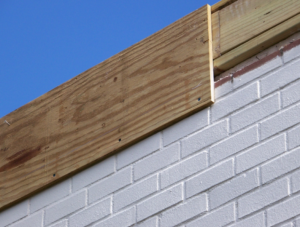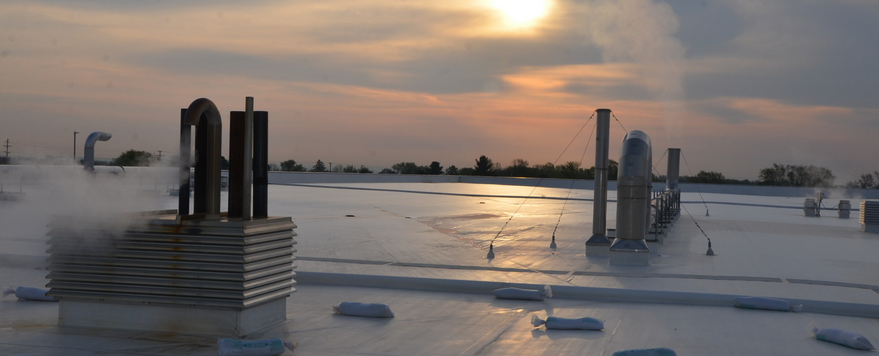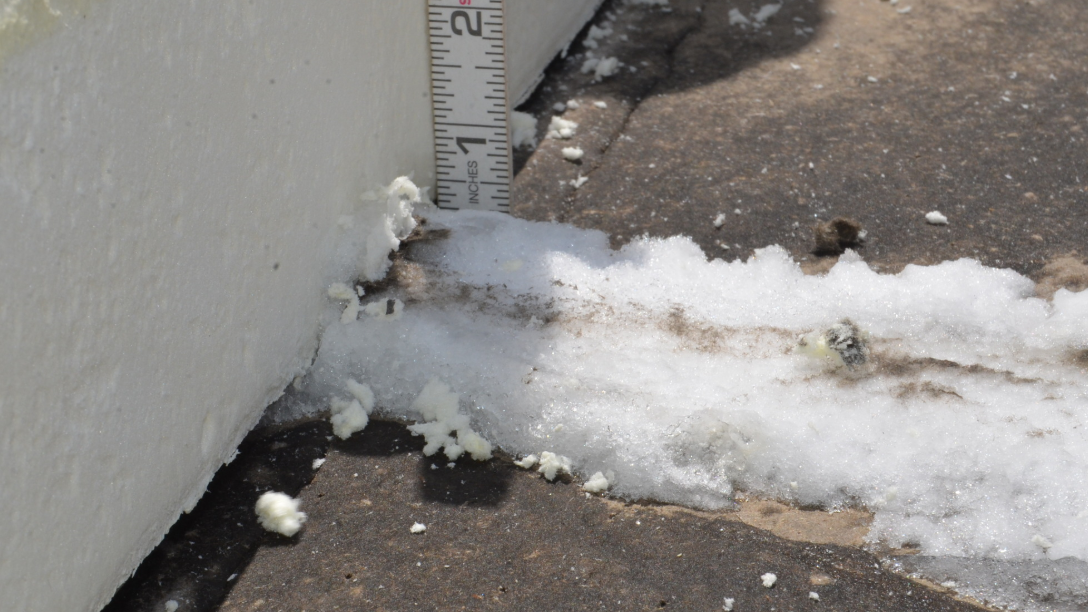Any isolated sections of gypsum roof decking exhibiting a “damp” surface condition were dried using a propane torch.
Project Details

The perimeter wood blocking was prefabricated and assembled offsite from pressure-treated 2- by 6-inch and 2- by 8-inch wood in a knee-wall configuration installed in 10-foot lengths. Doing so reduced the total quantity of blocking used on the project by nearly half (approximately 2,000 board-foot savings compared to installing multiple layers of blocking). The bottom blocking layer was anchored to the steel framing at 16-inch on-center intervals.
The entire project was undertaken in a single phase of work by an average of eight crew members. The building configuration and extent of water leakage did not lend itself to phasing the work.
The project design originally incorporated a mechanically fastened base sheet to which the tapered roof insulation system would be attached by means of low-rise polyurethane foam insulation adhesive. Mechanical attachment of the insulation directly to the roof decking was deemed to be cost prohibitive on account of the substrate construction, the poured gypsum decking and difficulties associated with the use of varying fastener lengths.
Fastener pull-out tests were performed using the specified base sheet fastener. Although satisfactory pullouts were achieved, the installation procedure resulted in damage to the roof decking. The density of the decking in this instance was considerably “harder” than that of traditional gypsum roof decking construction and required substantial effort to properly penetrate into the substrate, which consequently resulted in cracks and spalling in the gypsum and form board. An alternative method of roof insulation attachment therefore needed to be considered.
A field adhesion test was performed using the specified polyurethane foam insulation adhesive. Initially, it was believed a satisfactory bond could not be achieved using an adhesive because of the degree of moisture entrapment within the roof decking and consequently was not considered to be a viable alternative. However, the field adhesion test was successful and the method of insulation attachment proceeded on this basis.
Construction debris was transported across the roof surface via motorized buggies and removed by means of a forklift fitted with a debris box. Traffic ways consisting of loose-laid plywood sheathing were utilized to better disperse the construction loads. This proved to be effective; no resulting damage was incurred to the roof decking.

The perimeter wood blocking also was featured at plywood fascia to better stabilize the construction.
The perimeter metal flashing consisted of a shop fabricated 0.040-inch aluminum gravel stop and fascia extender with a Kynar finish. Each features a continuous cleat and closure to conceal the bottom edge of the plywood fascia. Transverse joints in the gravel stop and fascia extender were staggered by one-half length. The gravel stop was stripped-in using pressure-sensitive flashing.
The roof has been in place for approximately four years with no known performance issues. The building owner is very satisfied with the replacement roof system, design and contractor services.
Team
Roof Consultant: The Fisher Group LLC Oxford, Conn., (203) 888-5858
Roofing Contractor: F.J. Dahill Co. Inc. New Haven, Conn.
Materials
Polyiso: HP-H Tapered Polyiso from Carlisle SynTec Systems
EPDM: Kleen Sure-Seal 60-mil FR EPDM with Factory Applied Tape from Carlisle SynTec Systems
Low-rise Polyurethane Foam Insulation Adhesive: Fast Dual Cartridge Adhesive from Carlisle SynTec Systems
Base Sheet Fastener: Dual-Prong Base Sheet Fastener from Carlisle SynTec Systems
PHOTOS: The Fisher Group LLC





Be the first to comment on "After Years of Roof Leaks, a Laboratory That Produces Theatrical Equipment and Software Undergoes a Complex Reroofing"